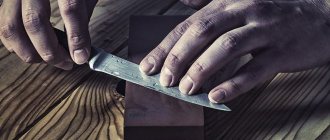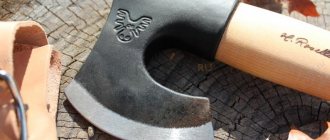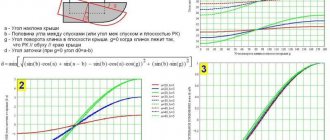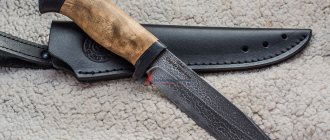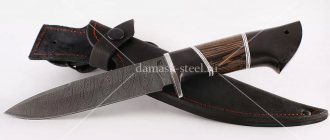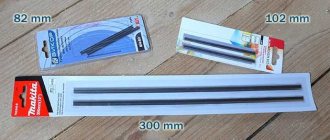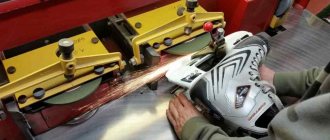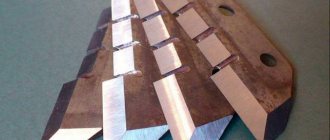When going out into nature, and even more so before hunting, you always need to make sure that the knife is not dull. You won't get far with a blunt weapon, but you still need to know how to sharpen a knife properly. This process takes some time, and you also need to take into account the type of steel from which the weapon is made in order to effectively sharpen it.
Exquisite knife
You can sharpen knives using the following tools:
- Grindstone
Sharpening stones vary in material and grain size. The most durable whetstone is diamond abrasive, sharpening knives faster than other materials. There is also a ceramic whetstone, and a “hard” one. They vary in grain size into fine, medium and high. It is impossible to sharpen knives efficiently using a stone of only one grain size; you always need to alternate them. To prepare a stone for work, it is necessary to remove small chips from it that remain on its surface after sharpening. To do this, you need to moisten it with water from a spray bottle. Diamond sharpening stones always require wetting.
- Sharpening machines (electrical and mechanical)
Tool sharpening is carried out on a special machine with abrasive discs. The blade should be evenly pressed against the abrasive wheel at an angle of 25-30 degrees at minimum speed. It is problematic to do such a procedure at home, and if you use the machine ineptly, you can ruin the knife.
A special electric sharpener is a very convenient tool. She herself selects the desired sharpening angle, suitable for any type of blade - scissors, knives, screwdrivers, etc. It can be used to sharpen fragile ceramic knives.
- Musat
It is a sword-shaped, cylindrical instrument with a handle, made of metal, ceramic or diamond-coated. When sharpening with this tool, you need to hold it correctly, namely: the grinder should rest against the wooden surface. The knife must be pressed with the blade at an acute angle to the musat near its handle, then lowered with an energetic movement towards the end of the musat. The same should be done with the other side of the blade. The movements are made in an arc, sharpening from the handle to the end of the blade. It should be taken into account that it is not possible to sharpen a dull blade with musat; it can only be used to straighten the edge of the weapon.
- Sharpening set
Sharpened knife with a whetstone
How to properly sharpen blades made of different steels
Knives made of the best metals - Damascus and damask steel - are sharpened differently than tools made of ordinary metals. But how to sharpen such knives correctly?
Damascus steel
Damascus steel knives cannot be sharpened using sharpening machines. Only hand sharpening should be used, since otherwise the tool will lose its unique properties, which are due to the mixture of hard and soft steels in its composition. Before sharpening a blade, you need to determine its hardness: the sharper the edge of the blade, the harder the metal. You need to sharpen a Damascus knife only along the blade, using a fine-grained sharpening stone with a gradual transition to “velvet” sandpaper.
Bulat steel
A blade made of damask steel must be sharpened with a wet whetstone, first with a coarse grain, then with a fine one, and finally the finishing is done on ceramics. The correct process of sharpening damask steel can be seen in the video.
There are various methods for sharpening a hunting blade. Let's look at two of them:
- To implement the first method you will need: a sharpening stone, a finishing belt and polishing paste. The surface of the sharpening block should be positioned at an angle of 10-15 degrees relative to the side surface of the knife blade. This will help you achieve the ideal sharpening angle, which is 35-45 degrees for hunting blades.
Reciprocating movements are performed perpendicular to the direction of the cutting edge. In this case, the sharp edge of the knife will resemble saw teeth, the dimensions of which will be directly proportional to the abrasive of the sharpening stone. When sharpening a blade, you need to do it slowly, starting from the handle to the end of the tip and back. Both edges of the blade are sharpened in turn. If the blade has not been sharpened for a long time or was sharpened unsuccessfully, it is necessary to press the knife with a block more firmly at the beginning of the process. As the required sharpening angle is reached, the pressure changes to a weaker one.
After this, you need to give the blade even more sharpness. To do this you will need a belt and polishing paste. The entire surface of the blade is applied to a strongly tensioned belt, then a reciprocating movement begins so that the belt is positioned perpendicular to the direction in which the knife is held.
Sharpening on a stone
- To implement the second method, you will need lemon zest, sandpaper with fine abrasive, and a sharpening stone.
Before properly sharpening a hunting knife, you need to check the hardness of the metal from which it is made. To do this, you can use a needle file by running it along the blade. The hardness of the blade is normal, if when pressed lightly the file will simply slide along the blade, and when pressed hard it will catch the steel a little.
Next, you need to take several sharpening stones with different grain sizes (usually three to five such stones are used). During sharpening, all sharpening stones are used sequentially, starting with the coarsest grain and ending with the fine grain. To keep knives sharp, you need to choose the correct sharpening amplitude. The movement of the whetstone should be directed against the sharpening of the blade, maintaining an average angle.
The final grinding of the blade is done with sandpaper. The blade is polished with a “pull” motion across the marks left by the sharpening tool. Grinding is carried out until even the slightest traces of sharpening become invisible. Again, it is important to maintain the correct sharpening angle. After this, the blade is rubbed with lemon zest to strengthen the surface of the knife.
It is very important to choose the right hunting knife. It is necessary to take into account many factors: length, width, shape, material of the handle and blade, sharpening angle. Much depends on the purpose of using the knife.
Tips for quickly sharpening a blade using improvised tools
Stone
You can quickly sharpen a knife on a hike or on a picnic using an ordinary cobblestone. Use any stone lying on the ground instead of a whetstone and run the knife blade along its surface. You won't achieve razor sharpness, but you will return the knife to working condition.
Second knife
It is quite possible to sharpen two knives at once, without sharpening stones or tools. To do this, you need to take a knife in both hands and begin to sharpen the blade of one knife on the blade of the other. After 5-10 minutes of this work, the knives will become sharper than before.
Glass objects
The knife blade can be slightly sharpened on the rough edge of glass or ceramic objects. For example, on the bottom of a glass or the edge of a tile. The main thing is that the surface is rough.
Leather belt
A leather belt is more suitable for finishing and giving the knife blade a razor sharpness than for rough sharpening. But if there is nothing at hand except a belt, then you can try to sharpen the knife on it. To do this, you need to tighten the belt and start moving the blade along it; you may not achieve strong sharpness, but you will polish the knife to a shine.
By learning to sharpen knives and tools yourself, you will acquire a skill that will be useful to you throughout your life!
There are many ways to restore the sharpness of a blade. You can sharpen knives manually or using special tools. Blade processing tools are divided into automatic and semi-automatic. With their help, damaged blades are restored, or cutting edges are simply straightened.
IMPORTANT! We should not forget that with each sharpening the amount of metal on the blade decreases.
We will help owners of cutting tools figure out how to properly sharpen knives using any of the proposed methods.
Types of hunting knives
With all the variety of characteristics of the offered hunting knives, they can be divided into two groups:
- General use, used to finish off prey. Their blades are smooth, the handle is necessarily equipped with a limiter.
- Special purpose (skinning, cutting meat from a bone, butchering an animal or poultry carcass).
They are also divided according to the type of blades and the sharpening of the upper edge. It can be straight or rounded. Handmade hunting knives are especially original in their design.
Choosing a hunting knife
Currently, a large selection of hunting knives is offered from manufacturers in different countries. Russian manufacturers are also not inferior in quality and variety of offered items. Their design is quite simple: a handle and a blade. The blade has a cutting part called the blade and is subject to periodic sharpening. To comply with safety precautions and ensure safety, a case made of durable and soft material (usually thick genuine leather with a wooden or plastic insert) is also very important. It must have a safety strap to prevent the weapon from falling out of its sheath.
When choosing a hunting knife, you must be guided by the main characteristics:
- The shape of the knife must correspond to the purpose of its use (the blade can be straight or curved).
- Sharpening hunting knives depends on their purpose.
- The handle should be comfortable when cutting carcasses. It can be located as a continuation of the blade, or at an angle to it. It is made from various materials: wood, metal, birch bark, ceramics, plastic. To prevent it from slipping out of your hands, it must have a stopper.
- Method of attaching the handle to the blade. A handle attached with a nut is much stronger than with glue.
- Blade material for hunting knives. The hardness of steel depends on the carbon content. The most valuable brands are damask and damask. For hunting knives, 50 to 60 HRC (Rockwell) is considered optimal. The steel must be anti-corrosion.
- Blade length and width. The optimal length is considered to be 12-13, width 3-3.5 cm.
Modern manufacturers of damask steel knives
Both foreign and domestic manufacturers are engaged in the production of damask knives. They can be divided into three conditional groups:
- Individuals producing knives in “artisanal conditions”. The quality and appearance of the product will be worse, but it will cost much less.
- Trademarks engaged in mass production and sale. They are of good quality, and the price ranges from 3,000 to 10,000 Russian rubles. Most people buy industrial knives.
- Masters specializing in the manufacture of damask knives. They sell products, as a rule, at exhibitions, providing complete information to buyers. For example, famous blacksmiths who create weapons from damask steel are I. Pampukha, S. Baranov and A. Biryukov. The price reaches tens of thousands of rubles, but such a weapon will last for many years, becoming a family heirloom.
Currently, knives made of damask steel and Damascus steel from Zlatoust and Kizlyar, as well as from smaller manufacturers, are widespread in Russia. These mass products are much worse in quality than the products of craftsmen, but they fully satisfy the requirements of the mass consumer, and they are affordable.
You can purchase them both in hunting and online stores. It is more convenient for hunters and fishermen to use a knife with a hook blade to cut up carcasses.
Methods for sharpening knives
Despite the hardness of the steel from which the knife is made, after a certain time its sharpness decreases. Therefore, it is necessary to periodically restore this function. Sharpening hunting knives can be done in various ways using:
- sharpening stone;
- musata;
- set of tools;
- special pocket sharpeners;
- (mechanical, electrical);
It should be remembered: the smaller the sharpening angle of a hunting knife, the more delicate work it is intended for. For hunting knives it is 15-30 degrees. For example, for cutting and boning work - 30, universal - 20, when skinning and separating meat from bones - 15 degrees.
As a rule, sharpening machines are used in manufacturing plants and in special tool sharpening points. But very often hunters do this on their own, using the other above-mentioned devices for sharpening hunting and
Sharpening tools
Touchstone (sharpening stone)
Sharpening stones are available with different numbers of abrasive grains per square millimeter. Therefore, for rough sharpening and finishing grinding, you need to use bars with a minimum and maximum abrasive content. In foreign-made whetstones, information about the number of abrasive grains is on their labeling. You have to choose domestically produced sharpening stones “by eye” or ask the seller which whetstone to use for initial sharpening and which for final sharpening.
Mechanical sharpener
Mechanical sharpeners are mainly used for sharpening kitchen knives. Although the sharpening process is quick, the quality leaves much to be desired. For this reason, for hunting and sporting knives, it is recommended to use other sharpening methods.
Electric sharpener
Modern models of electric sharpeners allow you to achieve high quality sharpening due to the built-in function of automatically determining the angle of the blade. The electric sharpener is perfect for both household use and for sharpening knives in catering establishments. The range of electric sharpeners is presented in a wide range, so the price may vary, but if you want your knives to always remain sharp, then buy more “advanced” and expensive models.
Musat
Musat - designed to maintain the sharpness of the knife edge. In shape, the musat resembles a round file with a handle. Musats are included in knife sets, and many owners often confuse them with a tool for fully sharpening a blade. Please note that with the help of musat you can maintain the sharpness of a sharpened knife, but if the knife has become completely dull, you will not be able to sharpen it with musat.
Sharpener "Lansky"
This sharpener is used for sharpening small and medium-sized knives. The design of the sharpener allows you to sharpen the blade at the angle you choose. The Lansky sharpener consists of a rod with a removable touchstone and two corners connected to each other. The corners simultaneously serve as a vice for the knife and a scale for selecting the sharpening angle. The sharpener kit also includes sharpening stones of different grits with ANSI markings.
Sharpening and grinding machines
Sharpening machines are used mainly in production for high-precision sharpening of rotating shaft blades. In addition to high-precision machines, there are electrically driven abrasive wheels and rotating discs for grinding. Sharpening knives on such machines should only be done by an experienced craftsman, because due to the speed of rotation of the circle or disk and the high heating temperature, with any unsuccessful movement, the knife blade will become unusable.
Sharpening a knife with a whetstone (stone)
Let's look at how to properly sharpen a hunting knife using a whetstone at home. When sharpening a knife using this method, you need to choose a flat, wide block at least 25 cm long with a rough structure. In this case, you must follow the sequence of actions:
- The block must be secured to a flat and stationary surface.
- Lubricate with oil (vegetable, technical) or soapy water so that the metal chips do not stick to the block, wait a few minutes.
- With smooth movements, begin sharpening with a moistened whetstone, pulling the knife along it under pressure along the entire length of the blade. We perform this action on both sides in turn. In this case, it is necessary to maintain the initial sharpening angle of the hunting knife.
- The process must be repeated several times until a new edge appears on top of the old one on both sides.
- Then the block is changed to a fine-grained stone and finishing is carried out without pressure, with light sliding movements.
To more conveniently secure the whetstone, you can make a frame in the form of a right angle and secure the block in it in an inclined position. You can use a special device to secure the sandpaper with an adjustable slope.
To control the quality of sharpening of hunting knives, you can try cutting a sheet of newspaper in a vertical position in one motion. The sharpening angle can be checked in the simplest way using ordinary scissors. You need to take them in your hands, insert the blade between them, gradually squeezing the blade of the knife. At the same time, for better visibility, point them at a bright light (lamp) to make sure the compression is tight. Then carefully remove the blade and measure the angle between the blades of the scissors with a protractor.
Do-it-yourself blade sharpening
Sharpening a knife with a whetstone
Sharpening a blade made with a sharpening stone is considered to be of the highest quality, provided, of course, that it was carried out by an experienced craftsman. To sharpen a knife on a whetstone, do the following:
How to sharpen a knife using a sharpening stone, see also in the video:
Sharpening a hunting knife on a Lansky sharpener
Hunting knives are made of hard steel, so their initial sharpening requires sharpening stones with a low content of abrasive grains.
How to sharpen knives in a Lansky sharpener, watch the video:
Sharpening scissors
Sharpening of scissors must be done on a special sharpening machine. Sharpening blades using improvised materials (sandpaper, the edge of a glass, etc.) can temporarily improve the sharpness of scissors, but not for long. If you do not have the opportunity to have your scissors sharpened by a professional, you can try to sharpen them yourself on an abrasive stone. When sharpening you need to follow a few simple rules:
When sharpening scissors, do not rush; patience will be your ally in this matter.
You can also watch the video on how to quickly sharpen scissors:
Sharpening plane and chisel blades
Sharpening the blade of a plane and a chisel are practically no different from each other. Therefore, the sharpening process described below applies to both tools:
In addition to manual sharpening, the chisel can be sharpened on a machine with a rotating abrasive disk:
Do not forget that when sharpening products on a machine, a lot of sparks and small particles are generated that can get into your eyes, so be sure to wear safety glasses. To avoid damaging your hands on the rotating disk, wear gloves.
You can also learn how to sharpen tools from the video:
Sharpening a knife with musat
Musat is a file with a round or cut cross-section on both sides and has a handle. It is made from very hard steel or diamond-coated ceramics. Musat usually only corrects blades that are not too dull. In this case, the cutting edge is not damaged even with repeated use. If a knife has completely lost its cutting properties, then you cannot sharpen it this way.
The process is carried out as follows:
- one hand holds the musat in a vertical position (on a non-slip surface);
- in the other hand we take the blade at an angle of 15-20 degrees, stretch it from top to bottom (from ourselves and to ourselves) along the entire length of the blade (first from one side, then from the other). Such repetitions should be done from 4 to 6. When using ceramic or diamond musat, once is enough.
Sharpening a knife using special kits and pocket sharpeners
The knife sharpening kit includes several stones with multi-colored handles, special guides and oil. The sharpening technology with these devices is simple and does not require special skills. Each compartment has its own fastening angle. The color of the handles determines the grain size of the sharpening stones. When using this method, the blade is sharpened perfectly.
Pocket sharpeners, offered in specialized stores, are small stones of various shapes (round, square, oval) that fit in the palm of your hand. As a rule, they are made from quality materials. They are located in special recesses made in a plastic case at a certain angle. These sharpeners are convenient to take with you when hunting or fishing, as they are compact and easy to use.
Dependence of the sharpening method on the steel grade
Not all sharpening methods are equally suitable for different grades of steel. For example, very popular knives made of Damascus steel cannot be sharpened on electric machines, since it has a non-uniform structure. It consists of alternating soft and hard layers, so the blade must be sharpened with extreme care, otherwise the edge of the blade will become ribbed and will crumble in the future. Knives made of this steel should be sharpened by hand, gradually changing the grain size of the stones towards a smaller size.
Bulat steel is characterized by increased hardness. Knives made from it need to be sharpened for a long time. In this case, electrical and mechanical machines are often used. You need to start with coarse-grained stones moistened with water, gradually moving towards fine-grained ones.
It should be noted that with the automated sharpening method it is not possible to achieve the sharpness and accuracy that is provided by manual work. The main advantage is the speed of this process.
Handmade hunting knives require a special approach when sharpening the blade, as they can be made from non-standard grades of steel. Therefore, it is recommended to sharpen them manually.
We conclude: proper sharpening of hunting knives is a very important process for maintaining appearance and durability. This hunting prop should be used only for its intended purpose and remember to keep it clean, periodically lubricating it with oil (both blades and wooden handles) to prevent loss of shine and drying out.
There are many ways to restore the sharpness of a blade. You can sharpen knives manually or using special tools. Blade processing tools are divided into automatic and semi-automatic. With their help, damaged blades are restored, or cutting edges are simply straightened.
IMPORTANT! We should not forget that with each sharpening the amount of metal on the blade decreases.
We will help owners of cutting tools figure out how to properly sharpen knives using any of the proposed methods.
Damascus and damask steel: history of origin and distribution across the planet
Damascus knives have been used for hunting since ancient times. They were used for cutting game, skinning dead animals, and in everyday life as a kitchen tool.
Such weapons were considered elite. It was valued for the following qualities:
- durability;
- excellent cutting qualities;
- the beauty of the material and patterns;
- strength, but at the same time flexibility of the blade.
The first mention in history of Damascus steel is associated with the time of Alexander the Great’s campaign in India. Then he clashed in battle with the army of the local king Porus. He was wearing a protective shell made of this alloy, on which Greek swords did not leave a scratch. The swords of Indian warriors were made from the same material.
During the Crusades, European warriors were amazed by the sharpness of Arab sabers made of Damascus steel. The crusading knights happily bought such weapons and brought them home as trophies.
There are three theories about the origin of the name of Damascus weapon:
- Damascus means “water” in Arabic. In documents of that time it was described as a blade, on the surface of which there is a pattern in the form of a rippling surface of water.
- This steel was produced in Damascus. However, this ancient city was more of a major trading city, rather than a weapons city. Therefore, most likely, it was only brought here from outside.
- Supporters of the latter refer to a certain weapons maker Damascus, after whom this material was named.
The manufacturing technology has spread around the world and received various names.
Mentions of damask blades are found in Aristotle, during the times of Ancient Greece. It is believed that Damascus was invented as a cheap analogue of damask steel.
The cutting qualities of both materials are approximately the same, but damask steel is somewhat stronger.
It should be noted that the secret of damask steel was lost. The second discovery of the secret of damask steel is associated with the name of Pavel Anosov.
He made cast damask steel in 1837, although he knew that this alloy had been produced in Russia even earlier, in the 16th and 17th centuries. (under the name “cold steel” or “haraluzhnaya” steel or “Russian damask steel”).
But the Russian gunsmith did not leave precise instructions for creating damask blades. And it remains unknown whether the domestic metallurgist reproduced the ancient manufacturing method, or created a new one.
Processing a blunt instrument on a machine
The industry produces various electric sharpeners for.
The entire mechanism is located in the housing, which makes working on the machine completely safe. No effort or special skills are required, so any housewife can easily cope with this task.
An electric motor rotates an axis on which several circles for various purposes are located. From rough to give the primary shape or restore the geometry of the blade, to polishing, which is used for final finishing.
Peculiarities of sharpening knives made of Damascus and damask steel.
A huge number of articles and even books are devoted to sharpening knives and other cutting tools. The topic is constantly discussed; there are established sharpening schools with their own masters and adherents. But does all this help the average cutting tool user? With this article I will try to clarify some of the features of sharpening blades made from my favorite patterned steels. To some extent, this is the “cry of the soul” of a person who sharpens knives that he made himself a lot and often. Having made a knife and sharpened it, I, as a rule, exchange it for certain material goods. This is how knives find their new owners. And this is where the fun begins. Most users immediately sharpen the knife, even before they start using it! The knives are produced sharpened to the point of easily shaving hair with a cutting edge angle of 22-25 degrees. The motives behind the resharpening are still unknown to me. Either this is an atavism of the Soviet era, when knives were sold that were frankly dull, or some kind of ritual of “taming” or “domesticating” a knife, similar to breaking horses. This is where the first difficulties begin, because many users do not have sufficient skill in sharpening knives. I am convinced of this by extensive experience in communicating with clients whose knives “stop cutting” after sharpening. I take the knife back, sharpen it, and - lo and behold! He cuts everything again, just a mystery of nature. Sometimes this ritual happens several times in a row, after which my faith in humanity undergoes further changes.
We are not talking about fans of exclusively manual sharpening, who proudly despise all sorts of enemy sharpening devices, like the famous Lansky sharpener. We will also not mention individuals who order a meat cleaver and only cut nails with it. I'm talking about people who use these sharpeners. It took quite a lot of time and statistical material to identify all the pitfalls and develop recommendations for proper sharpening. It is generally accepted that any man understands football, cars, weapons and knife sharpening. Is it so? Let's say you bought a gun in a store, and it seemed to you that its trigger was tight, although you had never fired it yet. What will you do? Will you take a file and start sharpening the parts of the trigger mechanism, although you are doing this for the first time and are not a gunsmith? What will they tell you in the store where you bring your gun with a complaint about the quality? What, this doesn't happen? And with knives all the time. Any work with your hands requires a certain skill, a minimum of knowledge and the right tool. And nothing more. Do they exist? The skill of high-quality handwork has become rare these days. What do we end up with? No one will hit themselves, their loved ones, on crooked hands; it’s easier to say that the knife is bad. And then I’m sincerely surprised that I have it sharp, but he doesn’t. Now let's move on to the practical part. As practice has shown, most problems arise from those who use Lansky and similar devices. Those who are used to sharpening knives only with their hands, and often do this, for the most part do not have any problems at all. Here we need to make a small digression and remind you that we are sharpening damascus or damask steel. These steels have certain features due to their structure. They are composite materials consisting of parts having different mechanical properties. Accordingly, the abrasive material will affect these parts differently. But more on that later. The knife sharpening device itself is quite convenient and allows you to accurately maintain a given angle of the knife, like other devices invented by mankind. The very principle of their operation allows you to work using only the spinal cord (I myself use a homemade and significantly improved analogue of “Lansky”, I need it to facilitate the work and “automate it”, since I sharpen a lot and sometimes in a short time).
But to use even such a simple device you need basic user skills. What mistakes are made when working with this sharpener? The last knife brought for “treatment” had a cutting edge in the form of steps, and even with a different sharpening angle. It turned out that instead of constant, uniform movement of the sharpening stone along the entire length of the edge, it was processed in sections equal to or slightly larger than the width of the jaws of the vice attached to the butt. Then the vice was rearranged, and a step appeared at the boundary of the zones, as the sharpening angle changed. On opposite sides, all these irregularities did not coincide. There is a widespread opinion that “Lansky” does not allow you to accurately maintain the sharpening angle - the further from the clamp, the smaller the angle, so you need to rearrange the clamp during the sharpening process. This is not true. To see this, let’s remember the school geometry course.
Let point A be the beginning of the RK; point B - end of the straight section of the RC; point C is an arbitrary point on a rounded section of the RC; point D - tip; point E is the point of contact between the guide pin and the hole. Points A, B, C, D belong to the same plane ABCD. From point E we lower a perpendicular to the plane ABCD. Let us call the point of intersection of the plane ABCD and the perpendicular F. The segment AB is perpendicular to the segment FB. Now consider a straight section of the RK, limited in the figure by points A and B. From the school geometry course it is known that a plane can be constructed using three points. Thus, we have one plane formed by points A, B and F, and another plane formed by points A, B and E. These planes intersect along the straight line to which segment AB belongs. “In life,” the ABE plane is the working plane of the abrasive stone and, in fact, the plane of the chamfer that forms the RK. The angle of intersection of two planes is naturally constant. As is the angle of the resulting RK. We have dealt with the straight section of the RK, let’s move on to the rounded section, represented in the figure by the BCD curve belonging to the ABCD plane. In order for a Lansky type sharpener to produce a sharpening angle that is the same along the entire length in such a section, it is necessary that the sections FB, FC, and FD be of equal length. Then we can consider the geometric body contained at points B, C, D and F to be a segment of a cone with a base radius equal to segments FB, FC, and FD and height EF. In reality, such a favorable situation rarely occurs, and the curvature of the blade does not coincide with the radius of the “ideal cone”, therefore the sharpening angle changes slightly. But it is almost always possible to secure the blade in such a way that this change in angle will be negligible. That is, there is absolutely no need to rearrange the clamp during the sharpening process. It would also be a good idea to make an exact template from cardboard or thin plastic that follows the contour of the blade, with a mark or rectangular cutout in the shape of the jaws of the clamp, which will allow you to install the clamp in exactly the same place during the next sharpening session. Changing the sharpening angle is also possible in the following cases: - if you press very hard on the block, the knitting needle bends and the angle becomes smaller; - if the knife slopes from the butt, fixing the clamp motionless becomes a very difficult task due to the lack of a flat platform, the edge “walks” » up and down when applying load (see picture);
The spoke is not pressed to the bottom edge of the hole, the angle of inclination fluctuates all the time. It is of great importance to secure the clamp with the blade at the workplace. It is best to secure the device motionlessly, for example, in a small vice. Of course, you can sharpen by holding the device suspended with the clamped blade, but firstly, you will quickly get tired, and secondly, in this position it is very difficult to control the pressing of the knitting needle to the lower edge of the hole. Although branded stands are not cheap, they often do not provide proper support for the device. The next surprise on the said knife was that the burr that appeared during sharpening was not removed! In one place it bent to the right, in another to the left, in the third it completely fell off. As a result, the knife cut with the remainder of the burr and quickly became dull. After sharpening with this knife, we planed an elk antler and a brass rod for a long time and tediously, without serious consequences for the cutting edge. The problems listed above are a consequence of improper use of the device and are easy to avoid. No less close attention should be paid to the stones that are included in the kit. Those that were based on diamond turned out to be unsuitable for sharpening damascus and damask steel, and non-diamond ones leave much to be desired! Super-hard diamond grains simply snatched hard carbides or relatively soft pieces in Damascus from the soft damask matrix. The diamond grains did not grind themselves down, gradually grinding down the metal, but simply gnawed at it. This is good at the preliminary stage of sharpening, when you need to sharpen a very dull knife, where you need a lot of metal removal. But at the final stage of sharpening, this led to chipping of the wheel and the inability to achieve proper sharpness. In principle, this problem did not arise on simple domestic white stones made of 25A electrocorundum. The abrasive, grinding itself down, gently and without jerking removed the metal. The knife was easily brought to the desired state and retained it for a long time. So when finishing sharpening patterned steels, you should use only abrasives that do not contain diamond. But using diamond paste applied to the skin will not be at all superfluous when finishing. But only a few movements on each side, otherwise it’s easy to polish the RK and it will lose its “anger”, it will cling worse to the material being cut. It is important here to maintain this fine line, which is also achieved through experience. No secret knowledge, no “orders of initiates” and narrow specialists, the problem is the lack of sustainable skill in working with hands in our age of disposable things. There is no need to edit or sharpen, repair or do it by hand; it’s easier to buy a bucket of disposable knives and throw them away when they wear out. Disposable life and disposable things, there is no longer a tradition of inheriting a knife from a grandfather or father, there are no connecting links between generations, there is no respect for manual labor. So where does the sharpening skill come from if, with a habitual movement, we broke off the tip of a cardboard cutter and for the next five minutes it is sharp again? Often this attitude is transferred to expensive, made-to-order and one-of-a-kind items. The result of this belief in your “disposable skills” is disappointment from the purchase and complaints to the master. Changing this attitude is difficult, and this article is intended to help avoid most mistakes. But no articles can replace live human communication between the master and the customer, kind and respectful communication. After all, by carefully finishing the knife, trying to remove the smallest jambs in polishing, and sharpening it sharply, the master shows his respect both for the future owner of the blade and for himself. So why shouldn’t the owner of a knife show respect for himself and the work of others by paying a little more attention to sharpening and caring for his beloved and often expensive acquisition? By sharpening your knife correctly and well, you will not only receive the pleasure of a job well done, but also a tool that is easy and pleasant to use. And you will be happy!
Damascus steel is considered one of the most expensive industrial metals. Knives made of this material compete with ceramic ones. They boast the following characteristics:
- spicy;
- long-term;
- functional;
- practical.
But even such a high-quality knife with a good blade requires care and periodic sharpening. They can have a wooden, plastic or metal handle. These knives are characterized by durability, they are: kitchen, hunting, folding, universal, specialized. It is worth noting that if you take such an instrument with you on a hike or on a picnic, you will not go wrong; it will serve you for a long time and with high quality. To sharpen it efficiently, it is better to contact a specialized service that has special machines and other equipment.
Our company and its highly qualified specialists provide such a service as sharpening Damascus steel knives on a machine. This type of procedure guarantees:
- quality;
- blade strength;
- long-term use.
The use of special steel requires a special attitude towards it. made of Damascus steel and will retain its best qualities.
